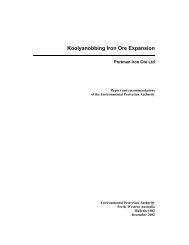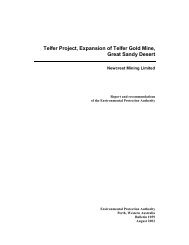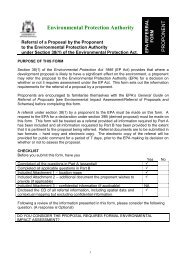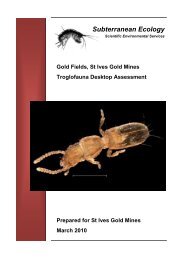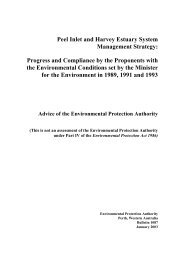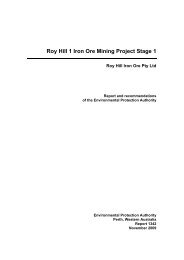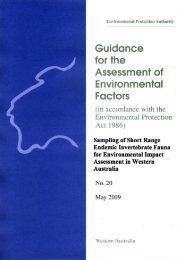Flora survey for Hamersley Drive recreation - Environmental ...
Flora survey for Hamersley Drive recreation - Environmental ...
Flora survey for Hamersley Drive recreation - Environmental ...
Create successful ePaper yourself
Turn your PDF publications into a flip-book with our unique Google optimized e-Paper software.
FRNP Improvement Project: Culham Inlet to <strong>Hamersley</strong> Inlet GF Craig– July 2010<br />
Appendix 1: Department of Environment and Conservation’s<br />
declared rare and priority flora list<br />
Appendix 1.1 Rare flora legislation and guidelines <strong>for</strong> gazettal<br />
The State Conservation Strategy, Wildlife Conservation Act, 1950, and Conservation and Land<br />
Management Act 1984 provide the guidelines and legislative basis <strong>for</strong> the conservation of the State's<br />
indigenous plant and animal species. Under the Wildlife Conservation Act, the Department of<br />
Environment and Conservation (DEC) is responsible <strong>for</strong> the protection of flora and fauna of all lands and<br />
waters throughout the State. Section 23F of the Act gives the Minister responsible <strong>for</strong> the Act statutory<br />
responsibility <strong>for</strong> the protection of those classes of flora declared to be rare.<br />
The Wildlife Conservation Act (1950-1985) protects all classes of indigenous flora throughout the State.<br />
Protected flora includes:<br />
Spermatophyta - flowering plants, conifers and cycads<br />
Pteridophyta - ferns and fern allies<br />
Bryophyta - mosses and liverworts<br />
Thallophyta - algae, fungi and lichens<br />
Section 23F of the Act provides special protection to those taxa (species, subspecies, varieties)<br />
considered by the Minister to be:<br />
* in danger of extinction - the taxon is in serious risk of disappearing from the wild state within one<br />
or two decades if present land use and other factors continue to operate;<br />
* rare - less than a few thousand adult plants of the taxon existing in the wild;<br />
* in need of Special Protection - the taxon is not presently in danger of extinction but is at risk over<br />
a longer period through continued depletion, or occurs largely on sites likely to experience<br />
changes in land use which could threaten its survival in the wild;<br />
or<br />
* presumed Extinct - taxa which have not been collected, or otherwise verified, over the past 50<br />
years despite thorough searching, or of which all known wild populations have been destroyed<br />
more recently.<br />
This is achieved by declaring them to be 'rare' by notice published in the Government Gazette. DEC's<br />
Policy Statement No.9 discusses the legislation relating to Declared Rare <strong>Flora</strong> and outlines the criteria<br />
<strong>for</strong> gazettal.<br />
Under the provisions of Section 23F, the 'taking' of Declared Rare <strong>Flora</strong> is prohibited by any person on<br />
any category of land throughout the State without the written consent of the Minister. A breach of the Act<br />
is liable to a penalty of up to $10 000. The legislation refers only to wild growing populations and applies<br />
equally to Government officers and private citizens on Crown and private land.<br />
To 'take' in relation to any flora includes 'to gather, pluck, cut, pull up, destroy, dig up, remove or injure<br />
the flora or to cause a permit the same to be done by any means'. This includes not only direct<br />
destruction or injury by human hand or machine but also such activities as allowing grazing by stock,<br />
introducing pathogens, altering water-tables so as to inundate or deprive the flora of adequate soil<br />
moisture, allowing air pollutants to harm foliage, and burning.<br />
The schedule published in the Government Gazette is revised annually to accommodate additions and<br />
deletions to the Declared Rare <strong>Flora</strong>. To qualify <strong>for</strong> gazettal, plants must satisfy certain requirements as<br />
defined in Policy Statement No.9, namely:<br />
* the taxon (species, subspecies, variety) must be well-defined, readily identifiable and<br />
represented by a voucher specimen in the State or National Herbarium. It need not be <strong>for</strong>mally<br />
31



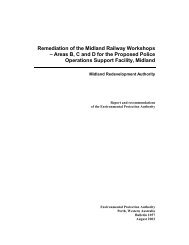
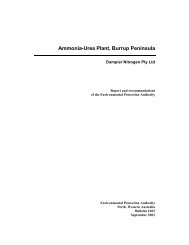
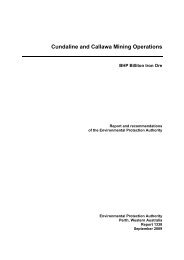
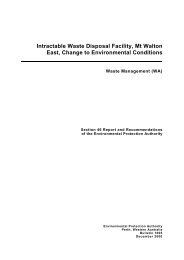
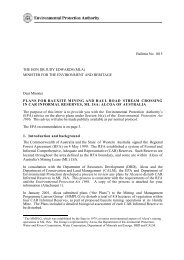
![[Project Title] - Environmental Protection Authority - The Western ...](https://img.yumpu.com/29001740/1/184x260/project-title-environmental-protection-authority-the-western-.jpg?quality=85)
